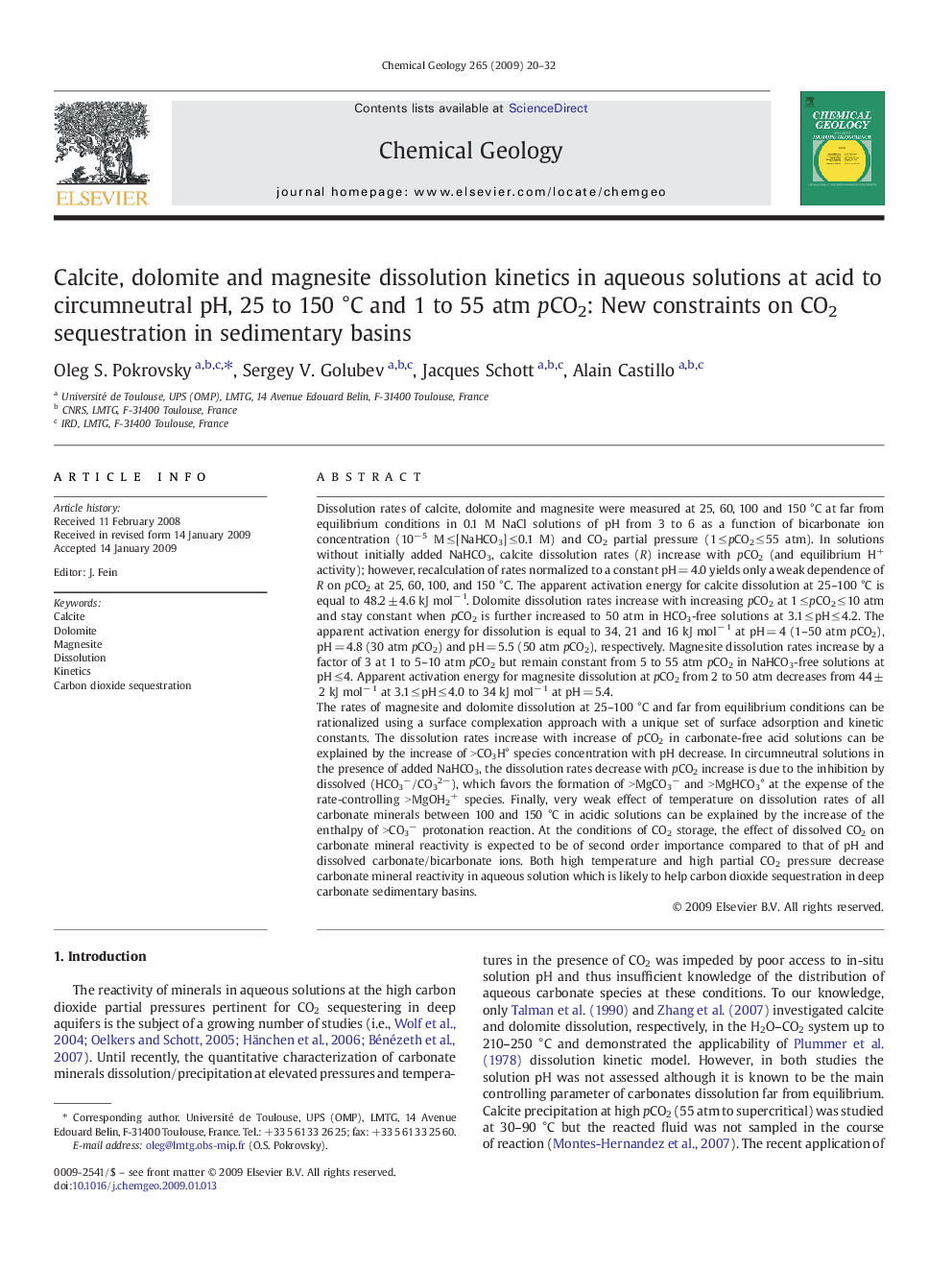| کد مقاله | کد نشریه | سال انتشار | مقاله انگلیسی | نسخه تمام متن |
|---|---|---|---|---|
| 4700143 | 1637704 | 2009 | 13 صفحه PDF | دانلود رایگان |

Dissolution rates of calcite, dolomite and magnesite were measured at 25, 60, 100 and 150 °C at far from equilibrium conditions in 0.1 M NaCl solutions of pH from 3 to 6 as a function of bicarbonate ion concentration (10− 5 M ≤ [NaHCO3] ≤ 0.1 M) and CO2 partial pressure (1 ≤ pCO2 ≤ 55 atm). In solutions without initially added NaHCO3, calcite dissolution rates (R) increase with pCO2 (and equilibrium H+ activity); however, recalculation of rates normalized to a constant pH = 4.0 yields only a weak dependence of R on pCO2 at 25, 60, 100, and 150 °C. The apparent activation energy for calcite dissolution at 25–100 °C is equal to 48.2 ± 4.6 kJ mol− 1. Dolomite dissolution rates increase with increasing pCO2 at 1 ≤ pCO2 ≤ 10 atm and stay constant when pCO2 is further increased to 50 atm in HCO3-free solutions at 3.1 ≤ pH ≤ 4.2. The apparent activation energy for dissolution is equal to 34, 21 and 16 kJ mol− 1 at pH = 4 (1–50 atm pCO2), pH = 4.8 (30 atm pCO2) and pH = 5.5 (50 atm pCO2), respectively. Magnesite dissolution rates increase by a factor of 3 at 1 to 5–10 atm pCO2 but remain constant from 5 to 55 atm pCO2 in NaHCO3-free solutions at pH ≤ 4. Apparent activation energy for magnesite dissolution at pCO2 from 2 to 50 atm decreases from 44 ± 2 kJ mol− 1 at 3.1 ≤ pH ≤ 4.0 to 34 kJ mol− 1 at pH = 5.4.The rates of magnesite and dolomite dissolution at 25–100 °C and far from equilibrium conditions can be rationalized using a surface complexation approach with a unique set of surface adsorption and kinetic constants. The dissolution rates increase with increase of pCO2 in carbonate-free acid solutions can be explained by the increase of >CO3H° species concentration with pH decrease. In circumneutral solutions in the presence of added NaHCO3, the dissolution rates decrease with pCO2 increase is due to the inhibition by dissolved (HCO3−/CO32−), which favors the formation of >MgCO3− and >MgHCO3° at the expense of the rate-controlling >MgOH2+ species. Finally, very weak effect of temperature on dissolution rates of all carbonate minerals between 100 and 150 °C in acidic solutions can be explained by the increase of the enthalpy of >CO3− protonation reaction. At the conditions of CO2 storage, the effect of dissolved CO2 on carbonate mineral reactivity is expected to be of second order importance compared to that of pH and dissolved carbonate/bicarbonate ions. Both high temperature and high partial CO2 pressure decrease carbonate mineral reactivity in aqueous solution which is likely to help carbon dioxide sequestration in deep carbonate sedimentary basins.
Journal: Chemical Geology - Volume 265, Issues 1–2, 15 July 2009, Pages 20–32